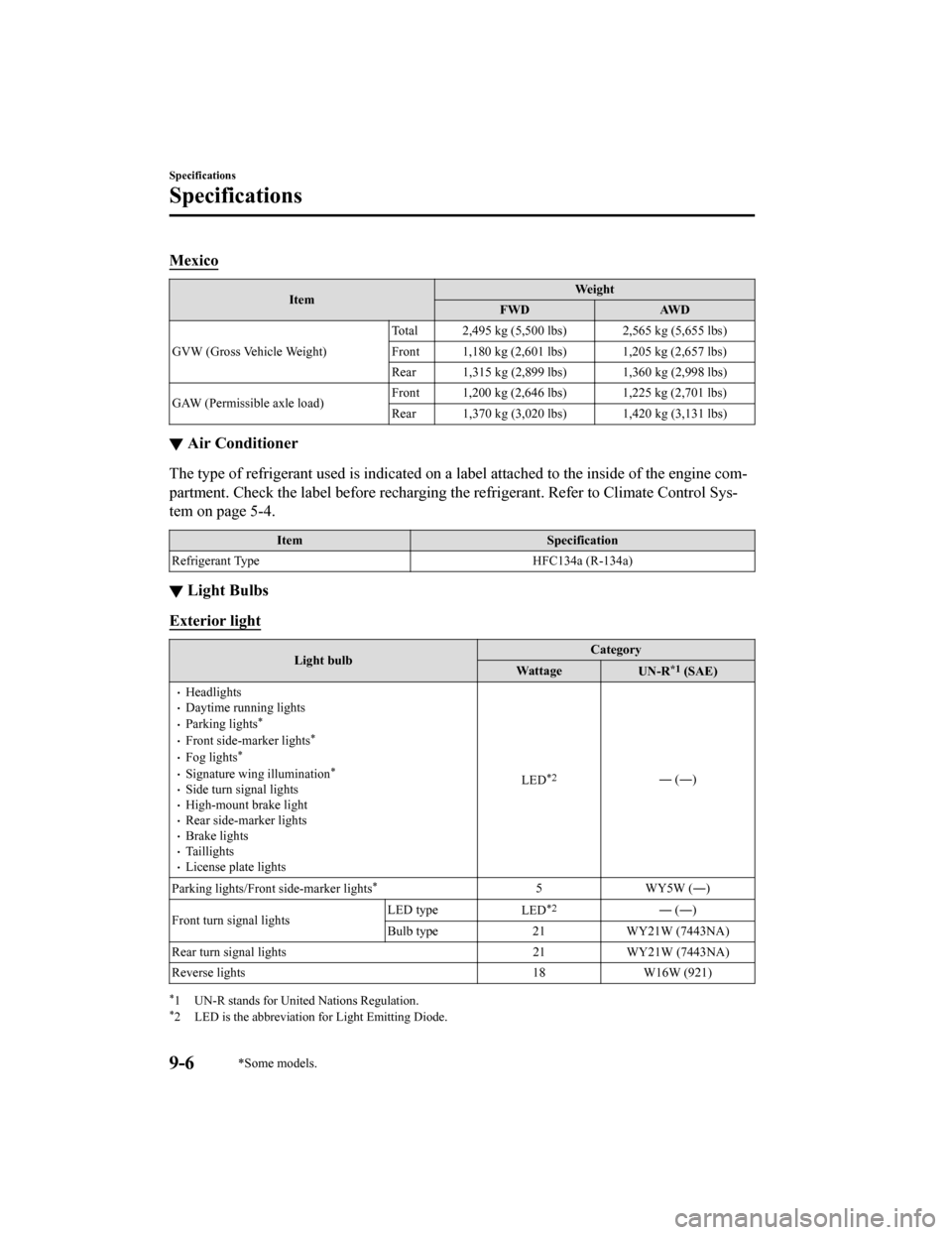climate control MAZDA MODEL CX-9 2020 (in English) User Guide
[x] Cancel search | Manufacturer: MAZDA, Model Year: 2020, Model line: MODEL CX-9, Model: MAZDA MODEL CX-9 2020Pages: 706
Page 416 of 706

▼Selecting the Airflow Mode
Dashboard Vents
Dashboard and Floor Vents Floor Vents
Interior Features
Climate Control System
5-12
CX-9_8HT8-EA-19I_Edition2_old
2019-9-24 13:14:55
Page 417 of 706

Rear Air Conditioner
Climate control system information is displayed on the display.
Mode selector switch
Airflow display
AUTO switchTemperature setting display
REAR switch
Mode selector display
Power switch
AU TO SYNC
Temperature control
switch
Fan control switch
▼Control Switches
Rear switch
Press the rear switch to operate the rear air
conditioner.
The indicator illuminates to indicate that
the rear air conditioner is operating.
AUTO switch
By pressing the AUTO switch the
following functions will be automatically
controlled in accordance with the set
temperature:
Airflow temperature
Amount of airflow
Selection of airflow mode
Power switch
The rear climate control system turns on
or off by pressing the power switch.
Temperature control switch
This switch controls
temperature. Press
for hot and for cold.
Operate the temperature control switch to
adjust the temperature between 15 °C (60
°F) and 29 °C (84 °F).
NOTE
When the temperature control switch is set
to the maximum or minimum, “Hi” or
“Lo” is indicated on the display.
Interior Features
Climate Control System
5-13
CX-9_8HT8-EA-19I_Edition2_old 2019-9-24 13:14:55
Page 418 of 706

Fan control switch
The fan has five speeds. The selected
speed will be displayed.
Mode selector switch
The desired airflow mode can be selected.
Refer to Selecting the Airflow Mode on
page 5-12.
▼Operation of Automatic Air
Conditioner
Operation from front seats
1. Turn the front air conditioner on.
2. Press the rear switch. The rear air
conditioner operates.
3. Selection of the airflow mode, airflow
amount and temperature will be
automatically contro lled to the same
temperature setting as the front air
conditioner for the driver's side.
NOTE
Set the control dial to the
recommended temperature of 22 °C
(72 °F), and then adjust it as
desired.
If the AUTO switch is pressed while
the front A/C switch is off, the rear
air conditioner operates only to
circulate air.
Setting the temperature to the
maximum high or low will not
provide the desired temperature at a
faster rate.
When selecting heat, the system will
restrict airflow until it has warmed
to prevent cold air from blowing out
of the vents.
When the rear air conditioner is
controlled to the same temperature
setting as the front air conditioner
for the driver's side, “SYNC” is
displayed on the rear screen.
When operating the fan switch of the
front air conditioner while the rear
air conditioner is operating
automatically, the airflow amount of
the rear air conditioner may change.
Operation from rear seats
1. Turn the front air conditioner on.
2. Press the AUTO switch. The selection of the airflow mode and airflow
amount will be automatically
controlled.
3. Use the temperature control switch to
set the desired temperature.
NOTE
Set the control switch to the
recommended temperature of 22 °C
(72 °F), and then adjust it as
desired.
If the AUTO switch is pressed while
the front A/C switch is off, the rear
air conditioner operates only to
circulate air.
Setting the temperature to the
maximum high or low will not
provide the desired temperature at a
faster rate.
When selecting heat, the system will
restrict airflow until it has warmed
to prevent cold air from blowing out
of the vents.
When the rear air conditioner is
operated automatic ally, “AUTO” is
displayed on the rear screen.
Interior Features
Climate Control System
5-14
CX-9_8HT8-EA-19I_Edition2_old 2019-9-24 13:14:55
Page 419 of 706

When the rear air conditioner is
controlled to the same temperature
setting as the front air conditioner
for the driver's side, “SYNC” is
displayed on the rear screen.
To turn off the syst em, press the Power
switch.
Interior Features
Climate Control System
5-15
CX-9_8HT8-EA-19I_Edition2_old 2019-9-24 13:14:55
Page 479 of 706

Voice Recognition
▼Basic Operation Method
Activating Voice Recognition
Press the talk button.
Ending Voice Recognition
Use one of the following methods:
Press the hang-up button.
Say, “Cancel”.
Operate the commander switch or the
center display (only when vehicle is
stopped).
Skipping Voice Guidance (for faster
operation)
Press and release the talk button.
Troubleshooting for Voice Recognition
If you do not understand an operation
method while in th e voice recognition
mode, say “Tutorial” or “Help”.
Commands useable anytime during
voice recognition
“Go Back” and “Cancel” are commands
which can be used at anytime during voice
recognition.
Returning to prev ious operation
To return to the previous operation, say,
“Go Back” while in voice recognition
mode.
Cancel
To put the Bluetooth
® Hands-Free system
in standby mode, say, “Cancel” while in
voice recognition mode.
To prevent a deterioration in the voice
recognition rate and voice quality, the
following points should be observed:
The voice recognition cannot be
performed while voice guidance or the
beep sound is operating. Wait until
the voice guidance or the beep sound
is finished before saying your
commands.
Phone related commands are available
only when your phone is connected via
Bluetooth
®. Make sure your phone is
connected via Bluetooth
® before you
operate phone related voice commands.
Music play commands, such as Play
Artist and Play Album can be used only
in USB audio mode.
Do not speak too slowly or loudly (no
loud voice).
Speak clearly, without pausing between
words or numbers.
Dialects or different wording other than
hands-free prompts cannot be
recognized by voice recognition. Speak
in the wording sp ecified by the voice
commands.
It is not necessary to face the
microphone or approach it. Speak the
voice commands while maintaining a
safe driving position.
Close the windows and/or the moonroof
to reduce loud noises from outside the
vehicle, or turn down the airflow of the
climate control system while Bluetooth
®
Hands-Free is being used.
Make sure the vents are not directing air
up towards the microphone.
NOTE
If the voice recognition performance is not
satisfactory.
Interior Features
Audio Set
5-75
CX-9_8HT8-EA-19I_Edition2_old 2019-9-24 13:14:55
Page 653 of 706

Uniform Tire Quality Grading System (UTQGS)
This information relates to the tire grading system developed by the U.S. National Highway
Traffic Safety Administration for grading t ires by tread wear, traction, and temperature
performance.
▼ Tr e a d We a r
The tread wear grade is a comparative rating based on the wear rate of the tire when tested
under controlled conditions on a
specified government test course.
For example, a tire graded 150 would wear on e-and-a-half times as well on the government
course as a tire graded 100.
The relative performance of tires depends upon the actual conditions of their use, however,
and may depart significantly from the norm because of variations in driving habits, service
practices and differences in road characteristics and climate.
▼ Traction-AA, A, B, C
The traction grades, from highest to lowest, are AA, A, B, and C. These grades represent the
tire's ability to stop on wet pavement as meas
ured under controlled conditions on specified
government test surfaces of asphalt and conc rete. A tire marked C may have poor traction
performance.
WA R N I N G
The traction grade assigned to this tire is based on braking (straight ahead) traction tests and
does not include acceleration cornering (turning), hydroplaning, or peak traction
characteristics.
▼ Te m p e r a t u r e - A , B , C
The temperature grades A (the highest), B, and C, represent the tire's resistance to the
generation of heat and its abili
ty to dissipate heat when tested under controlled conditions
on a specified indoor laboratory test wheel.
Sustained high temperature can cause the material of the tire to degenerate and reduce tire
life, and excessive temperatures can lead to sudden tire failure.
Grade C corresponds to a level of performance which all passenger vehicle tires must meet
under the Federal Motor Vehicle Safety Standard No. 109. Grades B and A represent higher
levels of performance on the laboratory test wheel than the minimum required by law.
Customer Information and Reporting Safety Defects
Uniform Tire Quality Grading System (UTQGS)
8-23
CX-9_8HT8-EA-19I_Edition2_old 2019-9-24 13:14:55
Page 686 of 706

Mexico
ItemWe i g h t
FWD AWD
GVW (Gross Vehicle Weight) Total 2,495 kg (5,500 lbs) 2,565 kg (5,655 lbs)
Front 1,180 kg (2,601 lbs) 1,205 kg (2,657 lbs)
Rear 1,315 kg (2,899 lbs) 1,360 kg (2,998 lbs)
GAW (Permissible axle load) Front 1,200 kg (2,646 lbs) 1,225 kg (2,701 lbs)
Rear 1,370 kg (3,020 lbs) 1,420 kg (3,131 lbs)
▼
Air Conditioner
The type of refrigerant used is indicated on a label attached to the inside of the engine com-
partment. Check the label before recharging
the refrigerant. Refer to Climate Control Sys-
tem on page 5-4.
Item Specification
Refrigerant Type HFC134a (R-134a)
▼Light Bulbs
Exterior light
Light bulb Category
Wat tage UN-R*1 (SAE)
HeadlightsDaytime running lightsParking lights*
Front side-marker lights*
Fog lights*
Signature wing illumination*
Side turn signal lightsHigh-mount brake lightRear side-marker lightsBrake lightsTaillightsLicense plate lights LED
*2―
(― )
Parking lights/Front side-marker lights
*5W Y5W (― )
Front turn signal lights LED type
LED
*2― (― )
Bulb type 21 WY21W (7443NA)
Rear turn signal lights 21WY21W (7443NA)
Reverse lights 18W16W (921)
*1 UN-R stands for United Nations Regulation.*2 LED is the abbreviation for Light Emitting Diode.
Specifications
Specifications
9-6*Some models.
CX-9_8HT8-EA-19I_Edition2_old 2019-9-24 13:14:55
Page 699 of 706

Index
Pad wear indicator....................... 4-92
Warning light............................... 4-92
Break-In Period.......... ....................... 3-49
C
Capacities............................................ 9-4
Carbon Monoxide............................. 3-31
Cell Phones....................................... 8-20
Center Console................................ 5-104
Child Restraint Categories of child-restraint
systems.........................................2-49
Child-restraint precautions.......... 2-44
Child-restraint system
installation................................... 2-49
Child-restraint system suitability for
various seat positions table..........2-51
Installing child-restraint
systems.........................................2-55
ISOFIX child-restraint systems
(Mexico)...................................... 2-64
LATCH child-restraint systems
(Except Mexico).......................... 2-64
Child Safety Locks for Rear Doors... 3-20
Climate Control System...................... 5-4 Front Air Conditioner....................5-7
Gas specifications.......................... 9-6
Operating tips................................ 5-4
Rear Air Conditioner. .................. 5-13
Vent Operation (Front).................. 5-5
Vent operation (Rear).................. 5-11
Collision warning.............................. 7-51
Coming Home Light......................... 4-71
Cruise Control................................. 4-212 Cruise control switch.................4-212
Cruise main indication (white)/cruise
set indication (green)................. 4-213
Cup Holder...................................... 5-102
Customer Assistance. .......................... 8-2
D
Daytime Running Lights................... 4-72
Defogger
Mirror...........................................4-79
Rear window........... .................... 4-78
Dimensions.......................................... 9-5
Display.............................................. 4-12
Distance Recognition Support System
(DRSS)............................................ 4-133 Indication on display................. 4-133
Door Locks........................................3-12
Drive Selection................................4-109
Driving In Flooded Ar ea...................3-54
Driving on Uneven Road.................. 3-55
Driving Tips
Automatic transaxle.....................4-67
Break-in period............................ 3-49
Driving in flooded area............... 3-54
Driving on uneven road...............3-55
Floor mat..................................... 3-51
Hazardous driving.. ..................... 3-50
Overloading............. .................... 3-54
Rocking the vehicle. .................... 3-51
Saving fuel and protection of the
environment................................. 3-49
Turbocharged vehicles.................3-56
Winter driving............................. 3-52
Dynamic Stability Control (DSC)... 4-102 TCS/DSC indicator light........... 4-102
E
Electric parking brake (EPB)............ 4-90
Electric Parking Brake (EPB) Warning
Beep...................................................7-49
Emergency Starting
Push-starting................................ 7-22
Starting a flooded engine............ 7-22
Emergency Towing Towing description...................... 7-25
10-3
CX-9_8HT8-EA-19I_Edition2_old 2019-9-24 13:14:55